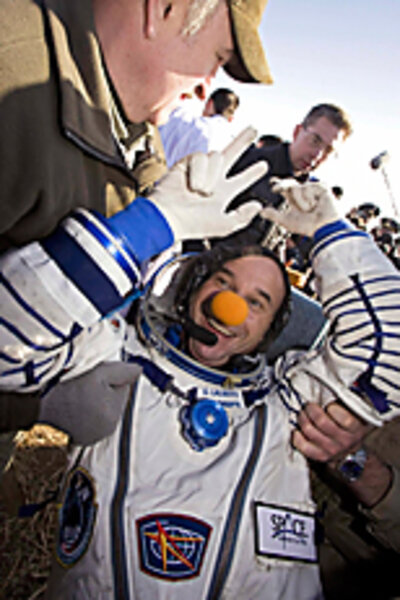Russia becomes the world's taxicab to space
Loading...
| Moscow
For better or mirth, it has become one of those indelible images from space: Canadian circus billionaire Guy Laliberté floating around the International Space Station wearing a red clown nose.
The stunt earlier this month by the founder of Cirque du Soleil, who once performed as a fire breather, was intended to provide a moment of levity for his wife and children during a video linkup. But it also served a more serious purpose: to draw attention to the crusade for which he paid $35 million to journey into orbit – the need for clean water on Earth.
Mr. Laliberté is the seventh space tourist to be sent aloft on Russian rockets. His odyssey, now over, shows how much the Russian space program has evolved since the pioneering days of Sputnik a half century ago, when the country's technological prowess was both the envy – and vexation – of the West.
Though hardly the juggernaut it was at the height of the cold war, the Russian space program today is also not just a cosmic limousine for wealthy clowns. In recent years, it has become something of a taxicab for spacefaring nations around the world.
Earlier this month, no fewer than three Soyuz spacecraft were docked at the International Space Station (ISS). During the recent grounding of US space shuttles, both Soyuz and Progress missions were essential to keeping the ISS going. At the same time, the Russians remain active in the satellite launch business. "This year we will have 44 flights, which is more than we had last year, and we spend less per flight than the Americans do," says Alexander Voro-byov, press secretary of RosKosmos, showing a touch of the old Russian pride.
The Russians are keeping a hand in unmanned space exploration as well. Future plans include Luna-Glob, a much-delayed lunar probe that is now slated to go up in 2012. Phobos-Grunt, a return probe to gather rock and soil samples from the Martian moon Phobos, now scheduled for 2011 (it had been slated to take off this month). And there is the proposed Venera-D probe to map Venus, slated for 2016.
Rising budgets have undergirded this activity. Starting in 2005, the government increased outlays to RosKosmos as the economy stabilized and oil revenues increased during the Putin years. For 2009, the budget is still at that higher level of around $2.5 billion, though no one is sure this can be maintained if the economic crisis continues.
"The situation in our national space industry is extremely difficult, but we hope for better times," says Igor Lisov, a columnist with Novosti Kosmonavtiki, a leading Russian journal of space science. "We manage to sell some flights [space tourism], but this really doesn't bring in much income. We've begun making a good business lofting communications satellites, and our own work goes on."
It is true that the Russian program remains a hologram of what it once was. During Soviet times, the space program was funded on par with NASA. With the fall of the USSR, the rubles dried up. The 1990s, in fact, were marked by many humiliations. For example, one copy of the Buran space shuttle, the Soviet Union's answer to the US space shuttle, ended up as a children's attraction in Moscow's Gorky Park, where it still sits beside the Moscow River, gathering fungus and looking forlorn.
The Mir space station, one of the most successful and long-lived (15 years) Soviet-era projects, had to be supported by private contributions, and there was talk of selling it off, perhaps to be an orbiting TV studio. In 2001, it was finally brought down and dumped into the South Pacific. It was this period that saw RosKosmos turn to moneymaking schemes such as satellite launches and space tourism.
"Much has been lost to us already, after many years of catastrophic neglect, and a lot will have to be rebuilt from the ground up," says Mr. Lisov. "Our space industry still relies on the old personnel, and it does not offer the kind of salaries that would attract talented young people. That will need to change if the space program is to have a future."
Still, RosKosmos retains a lot of Soviet-era space assets, such as Baikonur (which is in Kazakhstan) and other space launch centers. Star City, near Moscow, is a very impressive complex for training cosmonauts and controlling missions. Talk remains active here about a successor to the ISS, new generations of Russian rockets – the new Angara family, supposedly coming soon – and even a manned mission to Mars. But no one thinks 20th century-style space achievements will be possible without a whole new level of international cooperation.•





